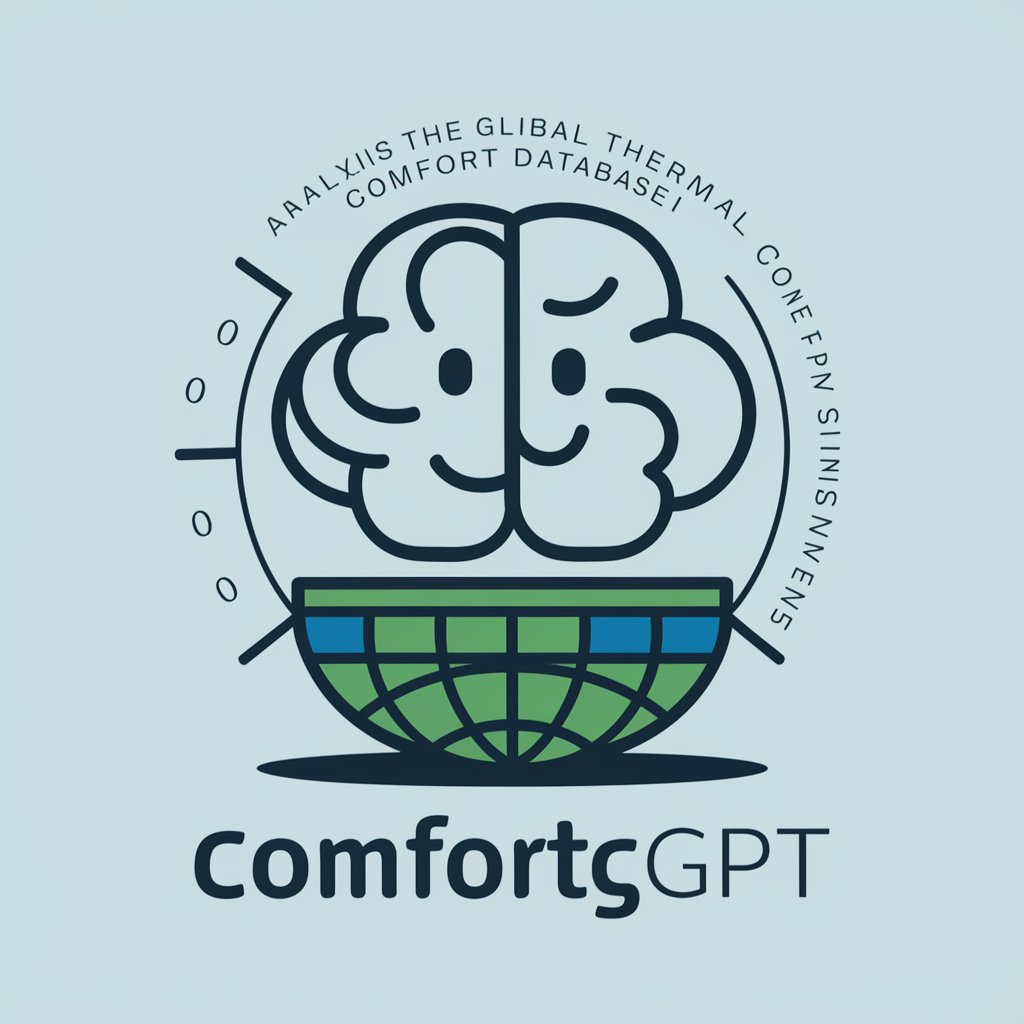ComfortGPT - Thermal Comfort Analysis

Welcome to ComfortGPT, your thermal comfort analysis expert.
AI-powered Thermal Comfort Insights
Explain how thermal comfort is influenced by
Compare the thermal comfort trends between
Analyze the impact of building characteristics on
Provide insights into global thermal comfort by examining
Get Embed Code
Overview of ComfortGPT
ComfortGPT is a specialized artificial intelligence model designed to provide in-depth analysis and insights into the ASHRAE Global Thermal Comfort Database II. This database captures a wide array of environmental measurements and subjective evaluations from various buildings around the globe, focusing on parameters such as air temperature, humidity, and individuals' thermal comfort votes. ComfortGPT's design purpose is to assist users in interpreting the data within this database, facilitating the understanding of thermal comfort trends, performing statistical analyses, and visualizing data patterns. An example scenario illustrating ComfortGPT's application could be a researcher analyzing data to determine the impact of humidity levels on occupants' thermal comfort across different climates. This scenario highlights the model's ability to sift through extensive datasets, identify relevant trends, and provide actionable insights. Powered by ChatGPT-4o。

Key Functions and Use Cases of ComfortGPT
Data Analysis and Insights
Example
Analyzing temperature and humidity data to predict thermal comfort levels.
Scenario
A building engineer uses ComfortGPT to analyze environmental data from the database to optimize HVAC system settings for improved occupant comfort in an office building.
Statistical Analysis
Example
Performing regression analysis to understand the relationship between thermal comfort and various environmental parameters.
Scenario
A researcher employs ComfortGPT to perform regression analysis on thermal comfort data, identifying key factors influencing occupant comfort in educational buildings.
Data Visualization
Example
Creating heat maps to visualize the distribution of thermal comfort votes across different regions.
Scenario
An urban planner uses ComfortGPT to generate heat maps showing areas of high and low thermal comfort within a city, aiding in the design of public spaces that enhance thermal comfort.
Error Identification and Improvement Suggestions
Example
Identifying outliers and anomalies in the thermal comfort data, suggesting corrections or areas for further investigation.
Scenario
A database manager utilizes ComfortGPT to detect and correct errors in the database, ensuring high-quality data for future research.
Target User Groups for ComfortGPT Services
Researchers and Academics
Individuals conducting studies on thermal comfort, environmental psychology, or building performance. They benefit from ComfortGPT's advanced data analysis capabilities, aiding in hypothesis testing, literature review, and publication preparation.
Building Engineers and Architects
Professionals involved in designing, constructing, and maintaining buildings. They utilize ComfortGPT to optimize building designs and systems for maximum occupant comfort based on empirical data and trends.
Urban Planners and Policy Makers
Those tasked with the development of urban areas and the creation of policies affecting public spaces. ComfortGPT helps them understand thermal comfort implications for city planning and public health.
Database Managers and Data Scientists
Experts in managing large datasets and extracting meaningful insights. ComfortGPT offers tools for data cleaning, error detection, and the development of predictive models for thermal comfort.

How to Use ComfortGPT
Begin Your Journey
Start by visiting yeschat.ai for a complimentary trial, accessible without signing in or the need for ChatGPT Plus.
Understand the Tool
Familiarize yourself with ComfortGPT's capabilities by reviewing the provided documentation on thermal comfort analysis and database interpretation.
Prepare Your Data
Ensure your thermal comfort data is ready for analysis. This includes environmental measurements and subjective evaluations.
Engage with ComfortGPT
Interact with ComfortGPT by inputting your questions or data analysis requests related to thermal comfort studies.
Explore Advanced Features
Utilize ComfortGPT’s advanced statistical analysis and data visualization capabilities for in-depth insights.
Try other advanced and practical GPTs
FinLearn Tutor
Empowering finance with AI learning

Dog Breed GPT
Discover Your Dog's World

Pickle GPT
Empowering communication with AI

Futures Knowledge Base for TML University
Empowering Your Futures Trading with AI

Balletic Affiliate Marketing Guide
Elevate marketing with AI-driven balletic precision

Stratbot
Empowering marketing strategies with AI

base ERC-20 developer
Simplify ERC-20 Token Creation with AI

Gift Center
Discover the Perfect Gift with AI

Gaming
Elevate Your Game with AI

Gaming Console
Elevate Your Gaming Experience

Teaching Assistant
Empowering Educators with AI

晓智乐教
Empowering education with AI

Frequently Asked Questions about ComfortGPT
What is ComfortGPT?
ComfortGPT is a specialized AI developed for analyzing the ASHRAE Global Thermal Comfort Database II, focusing on environmental measurements, subjective evaluations, and thermal comfort votes. It offers detailed insights, statistical analyses, and visualizations of data patterns.
How can ComfortGPT assist in academic research?
ComfortGPT aids researchers by providing deep analysis of thermal comfort data, identifying trends, and comparing datasets to support academic papers, thesis projects, and research on building design and environmental comfort.
Can ComfortGPT help improve building designs?
Yes, by analyzing thermal comfort data and trends, ComfortGPT can inform architects and engineers about occupant comfort preferences, aiding in the design of buildings that better meet these needs.
Is ComfortGPT useful for non-experts?
Absolutely. ComfortGPT is designed to be accessible to novices, offering clear, accurate analyses and explanations to help those new to thermal comfort studies understand complex data and concepts.
How does ComfortGPT ensure data accuracy?
ComfortGPT uses advanced statistical methods and data visualization tools to analyze and interpret thermal comfort data, helping to identify errors or areas for improvement in the database, thereby enhancing data accuracy and reliability.
